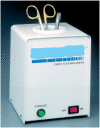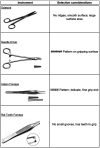Effectiveness of the Glass Bead Sterilizer for Sterilizing Surgical Instruments
- PMID: 35314021
- PMCID: PMC9137293
- DOI: 10.30802/AALAS-JAALAS-21-000053
Effectiveness of the Glass Bead Sterilizer for Sterilizing Surgical Instruments
Abstract
Survival rodent surgery requires the use of sterile instruments for each animal, which can be challenging when performing multiple surgeries on batches of animals. Glass bead sterilizers (GBS) are widely considered to facilitate this practice by sterilizing the tips of the instruments between animals. However, other disciplines have raised questions about the efficacy of the GBS, especially when used with surgical tools that have grooves or ridges that may contain organic debris. In this study, we evaluated the efficacy of the GBS to sterilize instruments commonly used in rodent surgery by intentionally contaminating a selection of instruments with a standardized bacterial broth inoculated with Staphylococcus aureus and Escherichia coli. As expected, a simple ethanol wipe was ineffective in sterilizing instruments in all treatment groups. An ethanol wipe followed by GBS was effective in sterilizing 82.5% (99 of 120) of the instruments. Our study suggests that the GBS may not be effective for consistent sterilization of surgical instruments.
Figures


Similar articles
-
Optimizing the Glass Bead Sterilization Protocol Focusing on Removal of Organic and Bacterial Intraoperative Contamination.J Am Assoc Lab Anim Sci. 2024 Jul 1;63(4):368-376. doi: 10.30802/AALAS-JAALAS-23-000122. Epub 2024 Mar 15. J Am Assoc Lab Anim Sci. 2024. PMID: 38490728 Free PMC article.
-
The Effectiveness of Hot Bead Sterilization in Maintaining Sterile Surgical Instrument Tips across Sequential Mouse Surgeries.J Am Assoc Lab Anim Sci. 2021 Nov 1;60(6):700-708. doi: 10.30802/AALAS-JAALAS-21-000047. Epub 2021 Nov 8. J Am Assoc Lab Anim Sci. 2021. PMID: 34749843 Free PMC article.
-
Glass bead sterilization of orthodontic bands.Am J Orthod Dentofacial Orthop. 1986 Sep;90(3):243-9. doi: 10.1016/0889-5406(86)90071-5. Am J Orthod Dentofacial Orthop. 1986. PMID: 3092637
-
Short-Cycle Autoclave Sterilization of Instruments in Same-Day Ophthalmic Surgeries: Rapid Review [Internet].Ottawa (ON): Canadian Agency for Drugs and Technologies in Health; 2024 Sep. Report No.: RC1547. Ottawa (ON): Canadian Agency for Drugs and Technologies in Health; 2024 Sep. Report No.: RC1547. PMID: 39466923 Free Books & Documents. Review.
-
Disinfection in veterinary practice.N Z Vet J. 1969 Jan-Feb;17(1-2):1-31. doi: 10.1080/00480169.1969.33773. N Z Vet J. 1969. PMID: 4890774 Review. No abstract available.
References
-
- Animal Welfare Regulations.2013. 9 CFR § 3.129.
-
- Bausch SJ. 2011. The operating room and asepsis, p. 66–73. In: Tear M, editor. Small animal surgical nursing. St. Louis (MO): Elsevier Mosby.
MeSH terms
Substances
LinkOut - more resources
Full Text Sources
Research Materials

